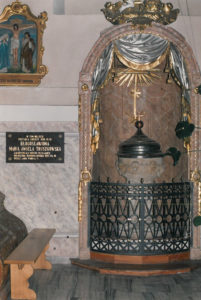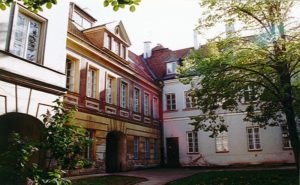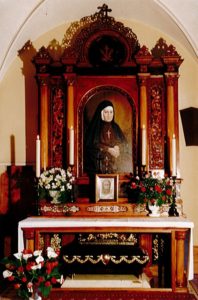Biography

The Baptismal Font where Sophia Camilla Truszkowska was baptized.

The location of the first Shelter at 10 Koscielna Street in Warsaw

The altar with Blessed Mary Angela's relics at the Immaculate Heart of Mary Church in Krakow
Blessed Mary Angela Truszkowska
was born in Kalisz on May 16, 1825, the oldest child of Joseph and Josepha Rudzinska. At her baptism she was given the name Sophia Camille. She received deep religious training in her family home. Already in her youngest years she distinguished herself with extraordinary sensitivity for the needs of the poor. After the family moved to Warszawa, Sophia attended the boarding school of Madame Guerin. As an adult, she joined the Society of St. Vincent de Paul, and upon the advice of Fr. Honorat Kozminski, her confessor, she entered the Third Order of St. Francis and became a tertiary. Destitution on the streets of Warszawa gave her no respite; for this reason in 1854, she rented a simple lodging near the Church of the Virgin Mary in Nowe Miasto for the little group of orphaned girls and elderly women whom she gathered off the streets. As the needs of the small institute began to increase, she had to transfer it twice, first to the home of the Dominicans on Mostowa St., and in July 1857, to the larger Zaluski Library building given to her by Countess Elfryda Zamoyska, known in Warszawa for her charitable undertakings. In this year also, Sophia, with several companions, donned the Franciscan habit and accepted a new name, Mary Angela. The residents of the Capital City, upon seeing the little group of children being led before the St. Felix altar in the Capuchin church, started calling them children of St. Felix. With time, the name Felician became associated with the sisters.
The next stage in the life of the young religious family and its Foundress was marked by work among the Greek Catholics in Podlasie. There she established many houses in which the sisters conducted centers for peasant children; however, the outbreak of the January Insurrection (1863) occasioned a change in the sisters' involvements. Centers were converted into hospitals where the wounded rebel soldiers received care. This Samaritan deed, however, did not "appeal" to the Russian occupants who in December 1864 issued an edict of suppression of the Congregation of Felician Sisters. The sisters had to remove their habits and return to their families. Only the cloistered sisters - separated from the active choir already in 1860 - were permitted to retain the religious garb and were transferred to the convent of the Bernardine Sisters in Lowicz. Mother Angela was among them. She remained at this convent for a year and a half after which time she moved to Krakow where the Congregation operated a center and maintained another house on 18 Mikolajska St., given to the sisters by Pelagia Russanowska. Because of the overcrowded conditions there, Mother Angela lived across the street in the home of Antonine Helclowa, but after several months, that is in autumn 1866, Mother took up residence in the acquired building. Her corner room was on the second floor, with a view onto Mikolajska and Sw. Krzyza Streets.
Mother now took over the helm of authority in the Felician Community. She expended efforts to obtain approbation of the Congregation in Galicia and planned on building a new convent. Several years later her health declined considerably and she began to gradually lose her hearing. Her request for release from the duties of governing the Congregation was finally granted. From that time on, Mother Angela directed her energies to editing the Constitutions of the Congregation. On January 20, 1870, Mother left the home on Mikolajska to live permanently in the new convent on Smolensk St. in Krakow. The building, not yet completed, was being constructed on property purchased several years earlier. Here Mother spent long, even nightly hours in adoration of the Blessed Sacrament in the Felician church where, since 1884, Jesus is exposed on the altar daily. She also embroidered liturgical vestments for poor chapels and grew flowers in the garden at Smolensk. Some writings referring to an episode in Mother's life at this time disclose that she was struck by the steering pole of a garden wagon thet worsened her health which was declining. Cancer eventually confined her to bed. On September 12, 1899, Mother received the anointing of the sick, and lived yet to see the approval of the Congregation by the Holy See several weeks before her death. After midnight on October 10, 1899, the Foundress went to the Lord to receive her deserved reward.
The cult of Mother Angela evolved after her death; however, the time to initiate her beatification process had to be postponed because of the political situation existing in the Polish government plus the two ensuing world wars. It was not until 1949 that Adam Cardinal Sapieha opened the Informative Process. The stages of this formal action, defined by Canon Law, advanced until 1969 when Karol Cardinal Wojtyla closed the process in Krakow and the Cause was accepted by the Holy See. On April 2, 1982, the Sacred Congregation for the Causes of Saints in Rome issued a decree of the heroicity of virtues of the Servant of God.
Upon confirmation of the miracle attributed to Mother Angela's intercession, the solemn beatification took place in St. Peter's Square in Rome on the memorable day, April 18, 1993.
Blessed Mary Angela's biography - Puzzles
Every event in the life of Blessed Mary Angela in this biography will lead to the puzzle. Just click on the title and follow the link. Images from the biography are the work of Sister Mary Kazimiera Tkacz, Felician Sister, and their originals are in the Museum and Archives of Mary Angela Truszkowska, the Blessed Foundress of the Felician Sisters in Krakow.
1. Kalisz - the Birthplace of Mother Angela
2. Baptism
3. Education
4. The First Holy Communion
5. Sickness
6. In Swizerland
7. The Zeal in the Service of God
8. The Sign in Cologne
9. In the Fire
10. Taking Care ofChildren and Elders
11. The Institute for the Poor
12. The Patron of the Congregation
13. TheWork Among the Children
14. With the Elderly
15. The First Rural Center
16. The News from the Uprising
17. The Suppression of the Congregation
18. Finally in Krakow
19. The Offering of the Hearts to Mother of God
20. The Gardener
21. The Death
22. Beatification
23. The Altar with the Relics of Blessed Mary Angela

